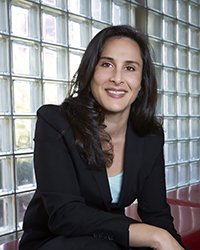Clearing New Paths to Justice

By Paul Szydelko
When Lydia Nussbaum was a first-year law student, she felt uncomfortable and even disillusioned with the often-binary approach to addressing legal problems. Rather than dwelling on the black-and-white limits, she became fascinated with the law’s gray areas—and more importantly, the stories of the people involved.
Her stint as a volunteer for a community mediation center in Baltimore opened her eyes to all the informal ways to achieve resolution and justice. “I loved it. It really resonated with me as a much more humane and much more effective way to address interpersonal problems,” Nussbaum says.
Since then, Nussbaum’s interest in alternative dispute resolution (ADR) has blossomed into a career passion—so much so that the William S. Boyd School of Law professor is also director of both the school’s Saltman Center for Conflict Resolution and Mediation Clinic. As a professor, the bulk of Nussbaum’s scholarship has centered on ADR.
Representing the many paths to settling conflicts outside of court, ADR began to gain momentum as a social and legal reform movement in the U.S. in the mid-1970s. The dispute resolution menu includes (among other options) mediation, arbitration, negotiation, and early neutral evaluation.
Over the decades, the legal system has adopted those various ADR methods with varying degrees of effectiveness. In fact, in some instances, ADR’s positive attributes have plateaued or even diminished. One example Nussbaum offers is mediation.
“In some contexts, mediation has lost its ability to be flexible, to be informal, to have tailor-made remedies that the parties are able to develop on their own terms,” she says. “It’s become more formalistic and formulaic, and that is concerning.”
In her scholarship, Nussbaum studies the trend of state legislatures mandating mediation in response to social issues. She’s written about how states deployed mediation to stem snowballing foreclosures and to achieve medical malpractice reform.
Nussbaum also is studying how ADR can stop the disturbing “school-to-prison pipeline,” in which schools turn to police and the criminal justice system to maintain order. She adds that the discipline policies schools have enacted and implemented result in disastrous consequences for some young people, particularly those of color.
Rather than a punitive response to student behavior, ADR processes that employ a restorative approach offer a better way to prevent and address disciplinary issues. However, Nussbaum notes that if lawmakers mandate restorative justice in schools, then stronger regulation would be needed to clarify what “restorative justice” means and to define standards of training and expertise for facilitators.
This principle applies whenever ADR is mandated as public policy, she says. Laws should be passed to ensure that participants embroiled in a dispute have adequate access to legal counsel or other advocates so they understand their legal rights and obligations, as well as the potential outcomes.
“If these dispute-resolution processes are going to be part of our legal system,” Nussbaum says, “they need to be buttressed in the same way that other forms of litigation process would be.”
In recent times, the ADR field has undergone a generational shift, and Nussbaum has made it her mission to support the next wave of scholars. As this year’s chair of the ADR section of the Association of American Law Schools, her goal is to identify and support new voices in the field. Another priority is to better integrate ADR techniques in classrooms.
After all, as Nussbaum asserts, many of the skills that make a quality dispute-resolution practitioner—asking open-ended questions, listening without judgment, redefining the problem, reordering priorities—are the same skills that make a quality attorney.
“Few students are interested in becoming mediators,” she says. “But most will have cases that go to mediation. So our students need to know [how] to prepare clients for mediation and how to select mediators that are a good fit for the specific issue, as well as the particular needs of their clients.”